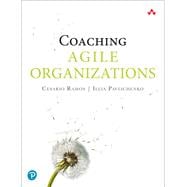
Creating Agile Organizations A Systemic Approach
by Ramos, Cesario; Pavlichenko, Ilia-
 Complimentary 7-Day eTextbook Access - Read more
When you rent or buy this book, you will receive complimentary 7-day online access to the eTextbook version from your PC, Mac, tablet, or smartphone. Feature not included on Marketplace Items.
Complimentary 7-Day eTextbook Access - Read more
When you rent or buy this book, you will receive complimentary 7-day online access to the eTextbook version from your PC, Mac, tablet, or smartphone. Feature not included on Marketplace Items.
Buy New
Rent Book
Rent Digital
Used Book
We're Sorry
Sold Out
How Marketplace Works:
- This item is offered by an independent seller and not shipped from our warehouse
- Item details like edition and cover design may differ from our description; see seller's comments before ordering.
- Sellers much confirm and ship within two business days; otherwise, the order will be cancelled and refunded.
- Marketplace purchases cannot be returned to eCampus.com. Contact the seller directly for inquiries; if no response within two days, contact customer service.
- Additional shipping costs apply to Marketplace purchases. Review shipping costs at checkout.
Summary
Author Biography
Table of Contents
Foreword by Craig Larman xix
Foreword by Dave West xxi
Preface xxiii
Introduction xxvii
Acknowledgments xxxv
About the Authors xxxvii
Part I: Foundational Concepts 1
Chapter 1: Organizing for Adaptability 3
Hello, VUCA World! 3
What Is an Agile Organization Design? 4
Typical Problems When Adopting Agility 6
Avoid Copy–Paste Scaling: A Typical Scaling Approach 10
Overview of an Agile Organization Design 11
Summary 16
References 17
Chapter 2: Systems Thinking 19
Basics of Systems Thinking 19
Applying Systems Thinking 31
Summary 48
References 49
Chapter 3: Optimize for Adaptiveness 51
What It Means to Be Adaptable 53
Flow Efficiency 54
Behavior of Queues 54
Queueing System Structures 61
Algorithm for Dealing with Queues 62
Choose an Operational Strategy 63
Summary 67
References 68
Chapter 4: Agile Organizational Design 69
Why Organizational Redesign? 70
Business Strategy Drives Organizational Design 71
Overview of a Design Process 72
Agile Organization Design Guidelines 73
Agile vs. Traditional Human Resources Management 101
Summary 104
References 105
Chapter 5: An Agile Adoption Approach 107
Principles of an Agile Adoption 107
Overview of an Adoption Approach 109
Overarching Adoption Guidelines 111
Applying Systems Thinking in Organizational Coaching 120
Summary 130
References 131
Chapter 6: Coaching for Change 133
Guideline 1: Influence People 134
Guideline 2: Co-Create the Change 136
Guideline 3: Voluntary Participation 139
Guideline 4: Acknowledge the Loss 144
Guideline 5: Deliver the Message Continually 147
Guideline 6: Help People to Cross the Edge 149
Guideline 7: Axes of Change 153
Guideline 8: Find the Right Balance of Radical/Incremental Change 159
Summary 161
References 162
Part II: Applying the Concepts 165
Chapter 7: Group Facilitation 167
Principles of Facilitation 167
Workshop Design 172
Facilitating Scrum Events 178
Summary 195
References 196
Chapter 8: Preparing the Product Group 197
Areas of Concern for Successful Preparation 197
Area 1: Involve the Managers 198
Area 2: Understand the Current Reality 204
Area 3: Create a Vision of the Future 221
Area 4: Identify the Product Group 233
Organizational Design to Eliminate Dependencies 242
Summary 249
References 250
Chapter 9: Launching the Product Group 251
Menu of Available Choices 252
Initial Product Backlog Refinement 253
Define the Definition of Done 257
Feature Team Adoption Map 260
Self-Designing Team Workshop 265
Team Lift-Off 270
Identify and Launch Communities 282
Identify Coordination Mechanisms 284
Create Useful Checklists 286
Summary 288
References 289
Chapter 10: Coaching Teams 291
The Building Blocks of the Agile Organization 291
Observations of an Agile Team 292
Building on the Team Lift-Off: Coaching Multifunctional Learning 296
Dealing with Recurrent Complex Problems in Teams: Systems Team Coaching 315
Improving Team Dynamics: Trust 329
Facilitate Feedback Loops for Learning: Learning New Practices 332
Summary 335
References 335
Chapter 11: Guiding the Product Ownership 337
What Makes a Team Product Owner? 337
The Product Owner in a Senior Position 341
Product Ownership Measures 345
Customer Understanding 347
The Product Owner Process 349
Stakeholder Alignment 351
Product Owner Leadership 354
Summary 356
References 357
Appendix Case Studies and Workshop Examples 359
Index 413
An electronic version of this book is available through VitalSource.
This book is viewable on PC, Mac, iPhone, iPad, iPod Touch, and most smartphones.
By purchasing, you will be able to view this book online, as well as download it, for the chosen number of days.
Digital License
You are licensing a digital product for a set duration. Durations are set forth in the product description, with "Lifetime" typically meaning five (5) years of online access and permanent download to a supported device. All licenses are non-transferable.
More details can be found here.
A downloadable version of this book is available through the eCampus Reader or compatible Adobe readers.
Applications are available on iOS, Android, PC, Mac, and Windows Mobile platforms.
Please view the compatibility matrix prior to purchase.
